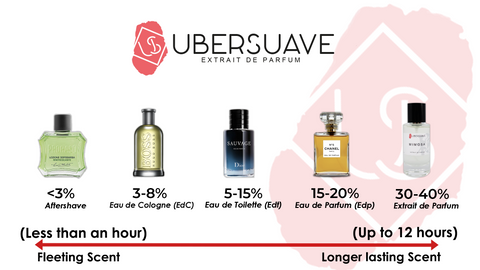Cologne, perfume, aftershave, eu de toilette, fragrances have many names but they generally share one main function; they make you smell irresistible. But what’s the difference between them? What’s the need for having different types when they technically do the same thing? And why are they priced differently?
It all boils down to fragrance concentration, these ‘nice smelling liquids’ are usually made up of the scent blend and a base. A scent blend can be a combination of essences, aromatic compounds and oils. Whilst, the base is usually either a mix of ethanol and water, or simply one of the two. A bottle of pure fragrance would be intoxicatingly strong and exuberantly priced. Therefore, the higher the concentration of fragrance in the bottle, the higher the price point. Higher concentrations also usually provide a longer lasting scent. At this point it's just finding a sweet spot between good scent longevity and price point, without breaking the bank!
Here’s a list of fragrance types and their concentrations.
AFTERSHAVE
Eau fraîche (literally "cold water") is used in the same way as eau de cologne: it is used during or after bathing. Even though some eaux fraîches contain alcohol, the majority of them are made up of water. It cleans and refreshes the skin thanks to its high water content and mild smell.
Because of advances in personal hygiene, aftershave's original meaning has all but vanished. The scented alcohol was first used as an antiseptic after shaving to clean any wounds.
As a result, they also use herbal herbs or balms to help soothe and cleanse the skin. Menthol, bay rum, and witch-hazel are still used in many aftershaves today for this reason.
Both aftershaves and eau fraîche appear to last no longer than an hour due to their low concentrations (<3%). These are typically used for personal grooming to improve the experience and are rarely appropriate for daytime wear.
COLOGNE
One of the most mysterious and perplexing fragrance types is Eau de Cologne. Cologne is often used as a generic word for men's fragrances, which is a misinterpretation of its original meaning. Eau de cologne is a form of perfume that originated in Köln, Germany.Its inventor wanted to create a fragrance that reminded him of his homeland of Italy. He named the concoction Kölnisch Wasser (Cologne water) after his new hometown.
Eau de colognes became an industry standard and are still used today. A light body with a delicate bergamot citrus head is one of their distinguishing features. Mäurer & Wirtz 4711, one of the oldest colognes in production, still faithfully follows this model today.
Modern perfumers often use eau de cologne as a strength designation for fragrances with a concentration of 3 to 8%. They're typically inexpensive, and the scent doesn't last longer than two hours.
EAU DE TOILETTE (EDT)

As a result, eau de cologne has taken over the original role of eau de toilette and is now used for freshening up. Cologne is applied after bathing and before a personal grooming routine because it disappears easily. Before leaving the shower, wearers will typically add the day's key scent.
In a nutshell, eau de toilette was a cleaning solution that could be added to bath water or applied directly to the skin after a bath. The word is now used in modern perfumery to describe a fragrance's concentration.
An eau de toilette is typically the most available and best-selling iteration of a fragrance because it is the most cost-effective choice. Eau de toilette concentrations range from 5% to 15%, but are most commonly around 10%.
An eau de toilette is usually a watered-down eau de parfum. They are readily available at most drug stores and retailers, but they do not last as long as parfums. They make ideal budget-friendly choices but are often let down by weak longevity that expires after 3 or 4 hours.
EAU DE PARFUM (EDP)
Nowadays, eau de parfums are more common than parfums. Since parfums are more expensive and unique, some perfumers will only sell an eau de parfum as the more luxurious version of a fragrance to increase sales.
Eaux de parfum typically has a concentration of 15% to 20%, which lasts for around 8 hours. A single application can have enough perfume to last all day at a fraction of the cost of a parfum.
Because of its longer lifespan, an eau de parfum version of a fragrance typically offers the best value for money.
PARFUM (EXTRAIT DE PARFUM)
Parfum is the most prestigious concentration of a scent, often referred to as "perfume extract," "parfum extrait," or even "elixir." They usually have a power of between 20 and 30 percent, but they can often reach a whopping 40 percent. They can last in upwards of 8 to 12 Hours.
They're usually much more costly than the alternatives. Some say that they are great value for money because the scent lasts much longer and doesn't need to be reapplied during the day with a small amount.
Similarly, the scent should be used sparingly due to its heady and opulent concentration. For this reason, some perfumes come in dab bottles, which have more power than an atomiser.
Furthermore, because of the lower alcohol content, this is a better option for those with sensitive skin that tends to dry out.
Parfums are a relatively unusual scent concentration for men these days. This is most likely due to the fact that they are very costly. However, it's possible that it's also due to the misunderstanding that "perfumes" are just for women.
Now that there’s more clarity between the types, it doesn’t mean that you should run to your nearest department store to get EDPs or Parfums since they last the longest which inherently means better value. There is a right tool for every job, similarly in this case, there is the right type for every occasion, and every occasion has their own ideal spray patterns too!





